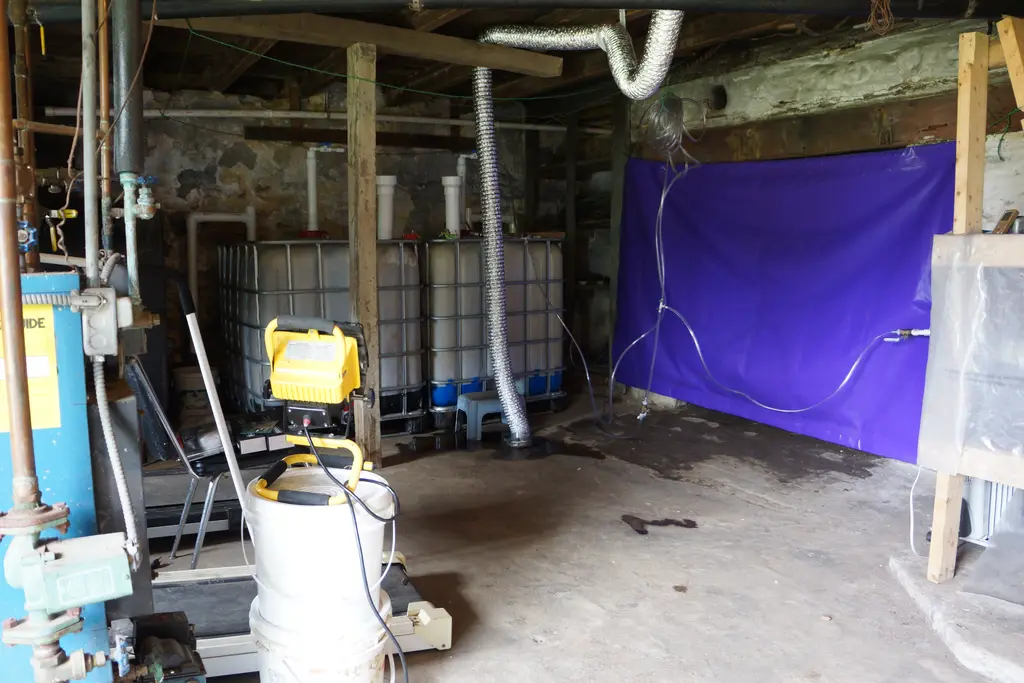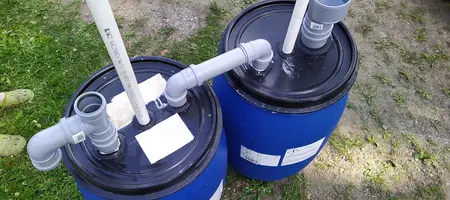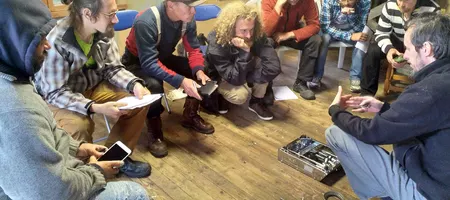Last part of the Biogas article originally written for Elonkehä. I suggest to read part 1 then part 2 before the article below.
Food for gas
But let‘s face it: Without feeding a digester nothing will happen at all. The amount of feeding a digester is derived from the Hydrolic Retention Time (HRT). It‘s the time the food we put into our digester takes to be decomposed and methane formed. At small scale digester we usually aim for a HRT of somewhere between 20 to 30 days. By a given size of 1 m³ of an IBC digester we could feed about 50kg / day. Those 50kg is a mixture of 25kg solids and 25kg water. My digester mostly gets food scraps in a mixture with green leaves or grass clippings. I aim for the same mixture as I would run a compost on. Compost specialists talk about the C/N ratio, which should be about 30/1 as far as I read. David House suggested the same ratio for a biogas digester at his „Biogas Handbook“. He also published a list of substances and home wast and their C/N ratio. Some words about Lignin: Lignin is a complex organic polymer that behaves like a stick in the mud when it comes to anaerobic digestion. It simply refuses to decompose. It is something you really don‘t want to put into your digester. It will form scum at the top of your digester and will just float there for a long time. Scum just causes trouble for us as it sooner or later will block our gas and effluent out pipes. And that’s something we don’t want. We want gas.
Gas storage
But gas needs to be stored somewhere as Methane is a very potent greenhouse gas. There are different possibilities around. Pretty common are gas storage bags made out of different materials, mostly PVC. But PVC is not that easy to process. I once visited a high frequency soldering facility in the United States to see the production of a prototype of a small scale carry on storage bag for showcasing gas storage bags for refugee camps. The benefits of the bags are: they are light and cheap. Their downside is that they can’t be pressured easily and when pressured we need to be carefully not to cause any damage to the bag. Leaks are something awkward but as H2S smells like rotten egg, so leaks could be detected easily and then repaired using bicycle repair kits. Another storage possibility is a so called floating drum. It is a very simple principle where one container sits inside another one where the upper one is able to float on the lower one which is filled with water.
Together with Martin Funk and TH I developed an Floating IBC storage based on the floating drum biogas system created by the Indians. It uses up two IBCs, is pretty straight forward, now used in EcoVillages all over Europe and at many places in the United States. The benefit is: the system is very sturdy and can be pressured. The downside is: it uses water and must be protected against freezing.
Usage of DIY biogas
When our storage systems are filled with gas than it is time to finally light up the blue flame. Its main usage is by far cooking. Actually I haven’t yet seen that many other usages. There are some that generate electricity from it using generators. The technical prerequisites are of course higher when we want to create electricity. The gas needs to be stripped off H2S, because H2S will corrode the engine’s pistons and therefore decrease the lifetime of the generator. Besides cooking and electricity Chinese companies also sell equipment for water heating and lighting. As Methane is lighter than air the usage of Biogas is pretty safe. So far I haven’t heard of any problems arising from the usage of Biogas from small scale Biogas digesters. At SolarC³ITIES we have a section at our Websites FAQ called “Is it safe”. I consider it a must read for anyone having doubts using it.
How much Biogas can we get?
On question we always get is how much gas could be created. The answer is always the same: it depends. A DIY biogas digester is a living creature that depends on what you feed, the living MO inside and the environment outside. If you want to control every detail of it and optimize all the numbers and settings you might get as much biogas as possible. If you don’t but care you still get a decent amount. I’m not going to crunch numbers here because that’s not what DIY is about. It is about the fun, the experiments, sharing the experience and findings.








